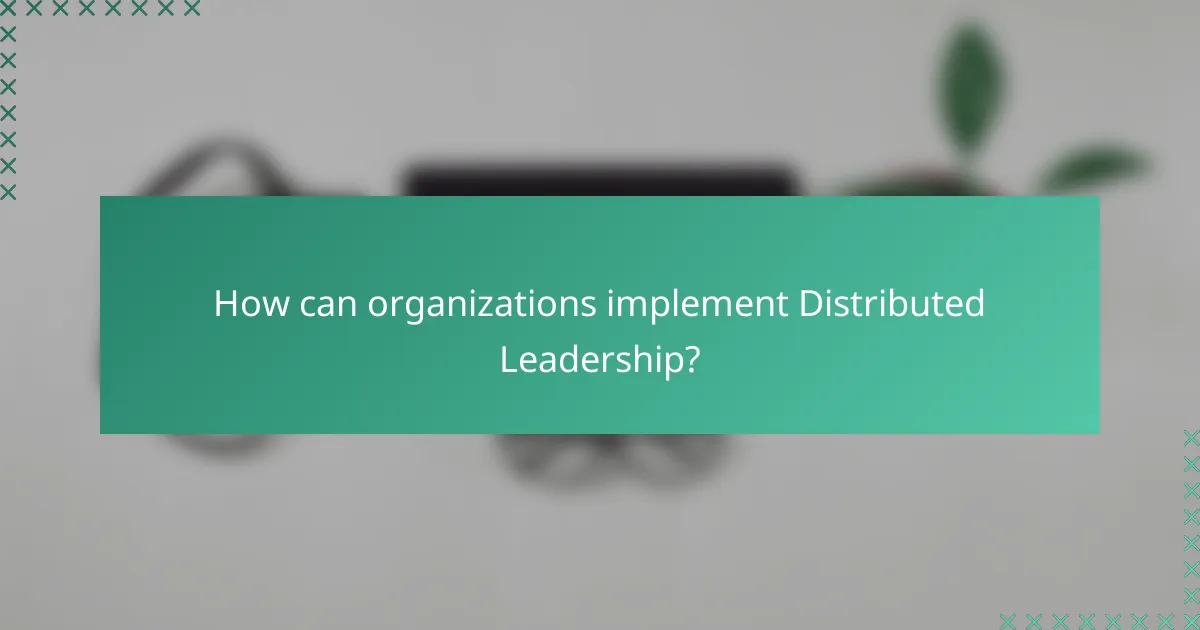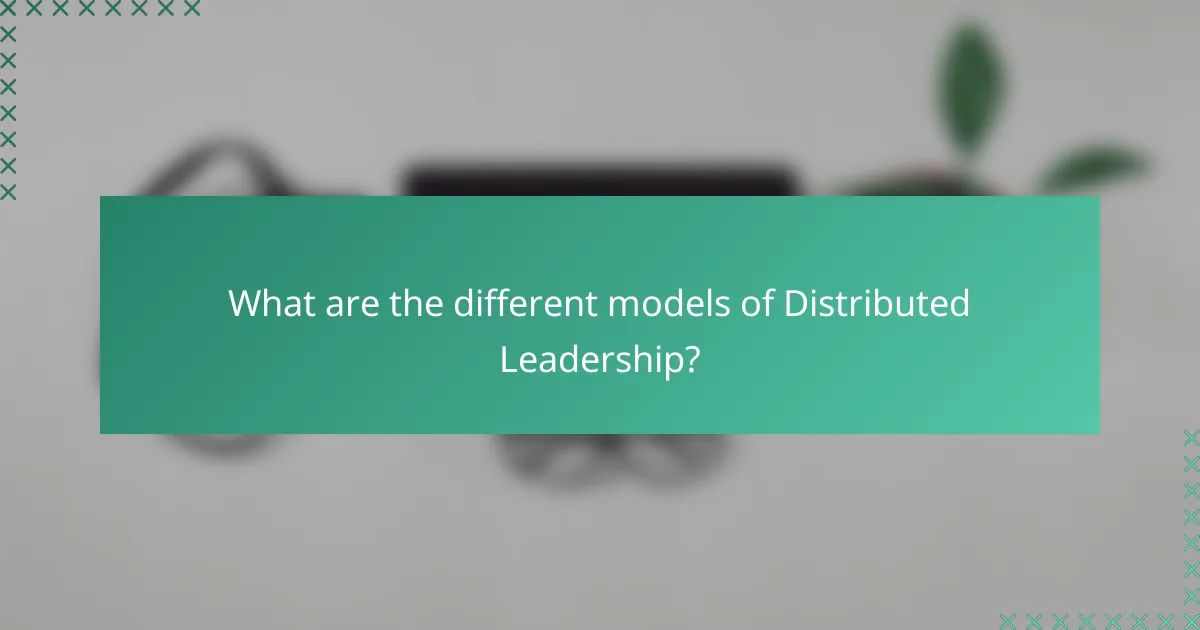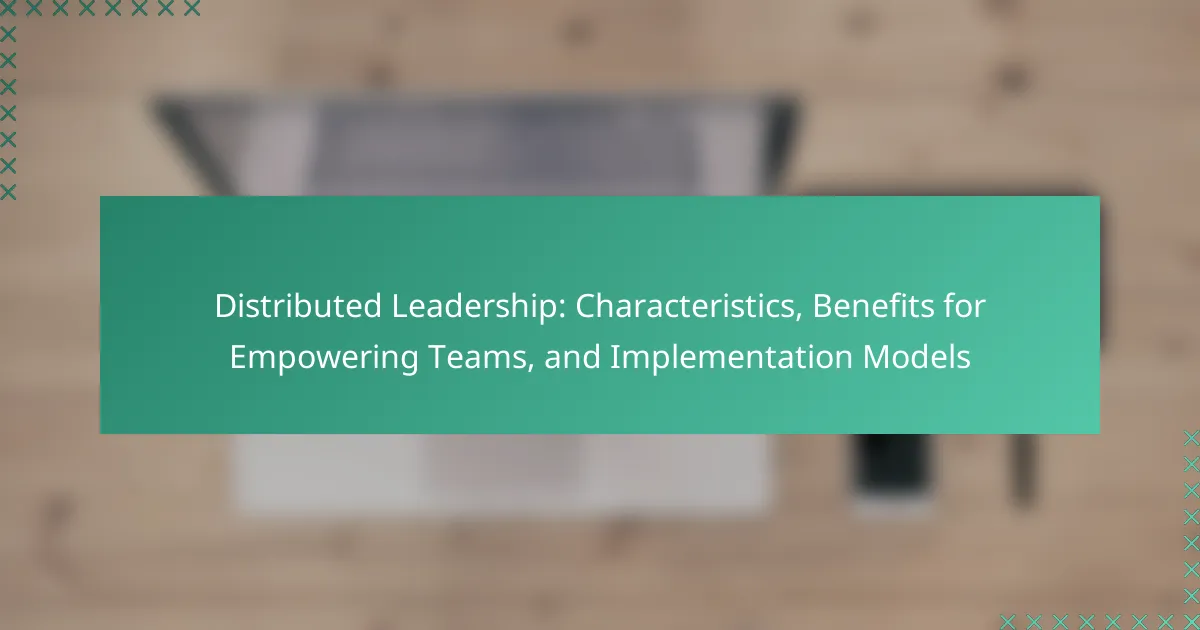Distributed leadership is a leadership approach that allocates authority and responsibility across various individuals within an organization, promoting collaboration and shared decision-making. This model facilitates the emergence of multiple leaders, each contributing their unique skills and perspectives, which can enhance team performance and engagement. Key characteristics of distributed leadership include shared leadership, collaborative leadership, and networked leadership, each offering distinct methods for empowering team members. Effective implementation requires fostering a culture of collaboration, establishing clear roles, providing leadership training, and enhancing communication channels. Research indicates that organizations adopting distributed leadership models experience improved accountability, trust, and overall effectiveness in responding to challenges and opportunities.

What is Distributed Leadership?
Distributed leadership is a leadership approach that distributes authority and responsibility among various individuals within an organization. It emphasizes collaboration and shared decision-making. This model allows multiple leaders to emerge, leveraging their unique skills and perspectives. Research shows that distributed leadership can enhance team performance and engagement. For instance, a study by Harris and Spillane highlights how this approach fosters a culture of trust and collective responsibility. By empowering team members, organizations can respond more effectively to challenges and opportunities.
How is Distributed Leadership defined in organizational contexts?
Distributed leadership is defined as a leadership approach where multiple individuals within an organization share responsibility for leadership tasks. This model emphasizes collaboration and collective decision-making among team members. It contrasts with traditional leadership, which typically relies on a single leader’s authority. Research indicates that distributed leadership can enhance team effectiveness and innovation. For example, a study by Harris and Spillane (2008) highlights how shared leadership fosters greater engagement and accountability among team members. This approach is increasingly adopted in educational and corporate settings to leverage diverse skills and perspectives.
What are the key characteristics of Distributed Leadership?
Distributed leadership is characterized by shared responsibility among team members. It promotes collaboration and collective decision-making. This approach empowers individuals at various levels within an organization. It encourages diverse perspectives and expertise to contribute to leadership tasks. Distributed leadership fosters a culture of trust and open communication. Accountability is also shared, leading to increased engagement and motivation. Research indicates that organizations utilizing distributed leadership often experience improved performance and innovation.
How does Distributed Leadership differ from traditional leadership models?
Distributed Leadership emphasizes shared decision-making and collaboration among team members. In contrast, traditional leadership models often concentrate power in a single leader. Distributed Leadership fosters empowerment and encourages participation from various individuals. This approach leads to increased innovation and adaptability within teams. Research indicates that organizations employing Distributed Leadership experience higher employee engagement. In contrast, traditional models may limit input and creativity. Consequently, Distributed Leadership can enhance overall team performance and satisfaction.
What are the core principles of Distributed Leadership?
Distributed leadership is characterized by the distribution of leadership roles across various individuals within an organization. It emphasizes collaboration and shared responsibility among team members. This approach fosters collective decision-making and empowers individuals at all levels. It encourages the development of leadership skills in a diverse group of people. Research indicates that distributed leadership can enhance organizational effectiveness and adaptability. A study by Spillane (2006) shows that when leadership is shared, it can lead to improved performance outcomes. In distributed leadership, relationships and interactions among team members are crucial for success. The principles focus on inclusivity, trust, and mutual support.
How do collaboration and shared decision-making manifest in Distributed Leadership?
Collaboration and shared decision-making manifest in Distributed Leadership through collective engagement and empowerment of team members. In this model, leadership responsibilities are distributed among various individuals rather than being centralized. This approach fosters a culture of collaboration where all members contribute their insights and expertise. Shared decision-making occurs as team members participate in discussions and influence outcomes. Research indicates that this inclusive process enhances commitment and accountability among team members. Studies show that organizations employing distributed leadership often experience increased innovation and problem-solving capabilities. These benefits arise from diverse perspectives being integrated into the decision-making process.
What role does trust play in Distributed Leadership environments?
Trust is essential in Distributed Leadership environments. It fosters collaboration among team members. High levels of trust increase communication effectiveness. When leaders trust their teams, they delegate responsibilities more freely. This delegation empowers individuals to take initiative. Research shows that trust leads to higher engagement levels. A study by Costa et al. (2016) found that trust enhances team performance. Trust also mitigates conflict and promotes a positive work culture. In summary, trust is a foundational element that enables successful distributed leadership.
What benefits does Distributed Leadership provide for teams?
Distributed Leadership enhances team performance through shared decision-making. It empowers team members to take initiative and contribute ideas. This approach fosters collaboration and improves communication among team members. Research indicates that teams utilizing distributed leadership show increased engagement and motivation. A study by Spillane (2006) highlights that distributed leadership leads to better problem-solving and innovation. Teams demonstrate greater adaptability in dynamic environments when leadership is distributed. Additionally, this model encourages accountability and ownership of tasks among team members. Overall, distributed leadership creates a more inclusive and effective team dynamic.
How does Distributed Leadership enhance team empowerment?
Distributed leadership enhances team empowerment by distributing decision-making authority among team members. This approach encourages collaboration and participation. Team members feel valued and responsible for outcomes. Empowerment leads to increased motivation and engagement. Research shows that teams with distributed leadership report higher satisfaction and performance. A study by Timperley and Robinson (2000) found that shared leadership models positively impact team dynamics. Empowered teams are more innovative and adaptable to change. Thus, distributed leadership fosters a culture of trust and shared responsibility.
What impact does Distributed Leadership have on team performance and innovation?
Distributed Leadership positively impacts team performance and innovation. It fosters collaboration among team members. This approach encourages shared decision-making and accountability. Teams with distributed leadership show higher levels of engagement. Research indicates that empowered teams are more innovative. A study by Harris and Spillane (2008) found that distributed leadership enhances collective efficacy. Teams operating under this model often adapt quicker to changes. This adaptability leads to improved problem-solving capabilities. Overall, distributed leadership creates a culture conducive to innovation and high performance.

How can organizations implement Distributed Leadership?
Organizations can implement Distributed Leadership by fostering a culture of collaboration and shared decision-making. They should establish clear roles and responsibilities across teams. This encourages individuals to take ownership of their tasks. Providing training and resources for leadership skills is essential. Organizations must also create communication channels that promote transparency. Regular feedback loops can enhance accountability and trust. Additionally, leveraging technology can facilitate coordination among team members. Studies show that organizations with distributed leadership models see improved engagement and performance.
What are the key steps in adopting a Distributed Leadership model?
The key steps in adopting a Distributed Leadership model include defining leadership roles, fostering collaboration, and empowering team members. First, organizations must clearly define the roles and responsibilities of each leader within the team. This clarity helps in distributing authority effectively. Next, fostering a culture of collaboration is essential. This involves creating an environment where team members feel comfortable sharing ideas and working together. Empowering team members is another critical step. This means providing them with the necessary resources and support to take initiative and make decisions. Additionally, training and development opportunities should be provided to enhance leadership skills across the team. Regular feedback and reflection on the leadership process are important for continuous improvement. These steps are supported by research indicating that distributed leadership can enhance engagement and performance in teams.
How can organizations identify suitable leaders within a Distributed Leadership framework?
Organizations can identify suitable leaders within a Distributed Leadership framework by assessing collaborative skills and shared decision-making abilities. Effective leaders in this framework demonstrate strong communication and interpersonal skills. They also show adaptability and a commitment to empowering team members. Organizations can evaluate potential leaders through performance reviews and peer feedback. Additionally, leadership development programs can help identify and nurture these skills. Research indicates that organizations with distributed leadership see improved team performance and engagement. This is supported by studies highlighting the correlation between leadership styles and team outcomes.
What training and resources are necessary for successful implementation?
Successful implementation of distributed leadership requires targeted training and adequate resources. Training should focus on leadership skills, collaboration techniques, and conflict resolution. Workshops and seminars can enhance understanding of distributed leadership principles. Resources must include access to leadership literature and case studies. Technology tools for communication and collaboration are also essential. For instance, platforms like Slack or Microsoft Teams facilitate team interaction. Additionally, mentorship programs can provide ongoing support and guidance. Research indicates that organizations with structured training see improved leadership effectiveness.
What challenges might organizations face in implementing Distributed Leadership?
Organizations may face several challenges in implementing Distributed Leadership. One major challenge is resistance to change from employees accustomed to traditional leadership styles. This resistance can manifest as skepticism or reluctance to embrace shared decision-making. Another challenge is the potential for role ambiguity, where team members may struggle to understand their responsibilities in a distributed model. This ambiguity can lead to confusion and decreased productivity.
Additionally, organizations may encounter difficulties in establishing effective communication channels. Clear communication is vital for collaboration and coordination among team members. Without it, misunderstandings can arise, impacting team dynamics. Moreover, there may be a lack of training and support for leaders and team members transitioning to a distributed leadership model. Insufficient training can hinder the development of necessary skills for effective collaboration.
Finally, organizations may face challenges in maintaining accountability. In a distributed leadership structure, it can be difficult to track performance and ensure that all team members are contributing effectively. This challenge can lead to uneven workloads and frustration among team members.
How can resistance to change be managed in the transition to Distributed Leadership?
Resistance to change in the transition to Distributed Leadership can be managed through effective communication and involvement. Clear communication helps to articulate the vision and benefits of Distributed Leadership. Involving team members in the decision-making process fosters ownership and reduces resistance. Training programs can equip individuals with necessary skills and knowledge. Providing support during the transition encourages adaptation. Regular feedback mechanisms can address concerns and improve the process. Research indicates that organizations with strong communication practices experience lower resistance levels. For example, a study by Kotter (1996) highlights that effective communication is crucial in change management.
What strategies can be employed to overcome communication barriers?
To overcome communication barriers, several strategies can be employed effectively. First, active listening is crucial. It ensures that all parties understand each other’s perspectives. Second, using clear and concise language minimizes misunderstandings. Avoiding jargon helps in making communication more accessible. Third, fostering an open environment encourages individuals to express their thoughts freely. This promotes transparency and trust among team members. Fourth, utilizing various communication tools can address different preferences. For instance, visual aids can enhance understanding for visual learners. Fifth, providing training on effective communication skills can equip team members with necessary techniques. Research shows that organizations with strong communication practices are 25% more productive. These strategies collectively enhance communication and reduce barriers in distributed leadership settings.

What are the different models of Distributed Leadership?
The different models of Distributed Leadership include shared leadership, collaborative leadership, and networked leadership. Shared leadership emphasizes collective decision-making among team members. This model allows individuals to take on leadership roles based on their expertise. Collaborative leadership focuses on partnerships and teamwork to achieve common goals. It encourages open communication and joint problem-solving. Networked leadership connects leaders across various levels and organizations. This model promotes sharing resources and knowledge to enhance effectiveness. Each model offers unique approaches to distributing leadership responsibilities. They all aim to empower individuals within teams and organizations.
What are the common frameworks for Distributed Leadership?
Common frameworks for Distributed Leadership include the Distributed Leadership Framework, the Adaptive Leadership Model, and the Shared Leadership Model. The Distributed Leadership Framework emphasizes collaboration among various leaders within an organization. This approach allows for a more flexible and responsive leadership style. The Adaptive Leadership Model focuses on the ability of leaders to adapt to changing environments. It encourages leaders to engage their teams in problem-solving. The Shared Leadership Model promotes collective decision-making among team members. This model helps to distribute authority and responsibility across the group. Each framework provides a unique perspective on how leadership can be effectively shared and distributed within organizations.
How do these models vary in their approach to team dynamics?
Different models of distributed leadership approach team dynamics in distinct ways. Some models emphasize collaboration and shared decision-making. Others focus on hierarchical structures with defined roles. For instance, the adaptive leadership model encourages flexibility and responsiveness to team needs. In contrast, the transformational leadership model fosters motivation and engagement among team members. Research indicates that collaborative models enhance trust and communication within teams. Hierarchical models can lead to clearer accountability but may stifle creativity. Each model’s effectiveness varies based on team context and goals. Thus, understanding these variations aids in selecting the appropriate approach for specific team dynamics.
What are the advantages and disadvantages of each model?
Distributed leadership models offer both advantages and disadvantages.
One advantage is enhanced collaboration among team members. This fosters a sense of ownership and accountability. Another advantage is the diverse perspectives brought into decision-making. This can lead to more innovative solutions.
A disadvantage is potential confusion over roles and responsibilities. This may result in conflicts or inefficiencies. Additionally, decision-making can become slower due to the need for consensus.
Research shows that clarity in communication can mitigate some disadvantages. A study by Harris and Spillane (2008) highlights the importance of structured processes in distributed leadership.
How can organizations measure the effectiveness of Distributed Leadership?
Organizations can measure the effectiveness of Distributed Leadership through various metrics and feedback mechanisms. Key performance indicators (KPIs) such as team collaboration, decision-making speed, and employee engagement levels can provide insights. Surveys and interviews can gauge team members’ perceptions of leadership distribution. Performance reviews can assess the impact of Distributed Leadership on project outcomes. Additionally, tracking innovation and problem-solving capabilities can reveal the effectiveness of this leadership style. Research indicates that organizations with effective Distributed Leadership often report higher employee satisfaction and productivity. For example, a study by Spillane and Diamond (2007) highlights that distributed leadership enhances team dynamics and organizational learning.
What metrics should be used to evaluate team performance under Distributed Leadership?
Key metrics to evaluate team performance under Distributed Leadership include collaboration effectiveness, decision-making speed, and individual accountability. Collaboration effectiveness can be assessed through team feedback and project outcomes. Decision-making speed can be measured by the time taken to reach consensus on critical issues. Individual accountability can be evaluated through performance reviews and goal achievement rates. These metrics provide insight into how well teams function under a distributed leadership model. Research by Spillane (2006) highlights that effective collaboration and shared responsibility enhance team performance.
How can feedback mechanisms be integrated into the evaluation process?
Feedback mechanisms can be integrated into the evaluation process by establishing regular intervals for collecting input. This can include surveys, interviews, or focus groups to gather diverse perspectives. Utilizing technology platforms can streamline data collection and analysis. Incorporating feedback into decision-making enhances transparency and accountability. This approach aligns with distributed leadership principles by empowering team members to contribute. Research shows that organizations utilizing feedback loops experience improved performance and engagement. For instance, a study by Hattie and Timperley (2007) indicates that effective feedback significantly enhances learning outcomes.
What best practices can organizations follow for effective Distributed Leadership?
Organizations can follow several best practices for effective Distributed Leadership. First, they should foster a culture of trust and collaboration. This encourages team members to share ideas and take initiative. Second, clear communication channels must be established. This allows for transparency and alignment on goals. Third, organizations should empower individuals by delegating authority. This enhances decision-making at all levels. Fourth, ongoing training and development are essential. This equips team members with the skills needed for leadership roles. Fifth, organizations should recognize and celebrate contributions. This motivates individuals and reinforces the value of distributed leadership. Research shows that organizations implementing these practices see improved team performance and engagement.
How can organizations foster a culture that supports Distributed Leadership?
Organizations can foster a culture that supports Distributed Leadership by promoting collaboration and shared decision-making. This involves creating a trust-based environment where team members feel empowered to contribute ideas. Training programs can enhance leadership skills across all levels. Regular communication encourages transparency and inclusiveness in discussions. Recognition of individual contributions boosts morale and reinforces shared leadership. Additionally, implementing feedback mechanisms allows for continuous improvement in leadership practices. Research indicates that organizations with distributed leadership see increased employee engagement and innovation. For instance, a study by Timperley and Alton-Lee (2008) in the “Review of Educational Research” highlights the positive impact of distributed leadership on team performance.
What ongoing support and development are essential for sustaining Distributed Leadership?
Ongoing support and development essential for sustaining Distributed Leadership include continuous training, clear communication, and collaborative practices. Continuous training ensures that leaders and team members develop necessary skills. Regular workshops and seminars can enhance leadership capabilities. Clear communication fosters transparency among team members. It helps in aligning goals and expectations. Collaborative practices encourage shared decision-making. This builds trust and accountability within teams. Research shows that organizations with strong support systems see improved team performance and engagement. For instance, a study by Harris and Spillane (2008) emphasizes the importance of professional development in sustaining distributed leadership.
Distributed leadership is a collaborative leadership approach that distributes authority and responsibility among multiple individuals within an organization, enhancing team performance and engagement. This article explores the key characteristics and principles of distributed leadership, contrasting it with traditional leadership models, and highlights its benefits such as increased innovation, accountability, and adaptability. It also outlines strategies for implementation, including defining roles, fostering collaboration, and providing necessary training, while addressing potential challenges like resistance to change and communication barriers. Lastly, the article discusses various models and frameworks of distributed leadership, offering best practices for organizations to sustain this approach effectively.
